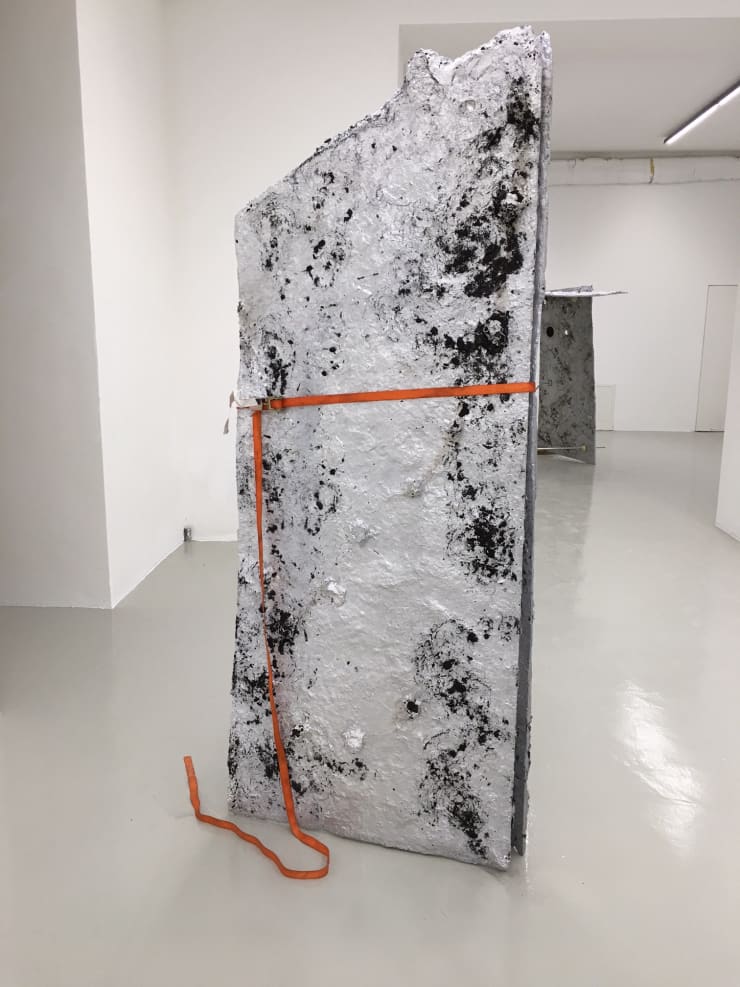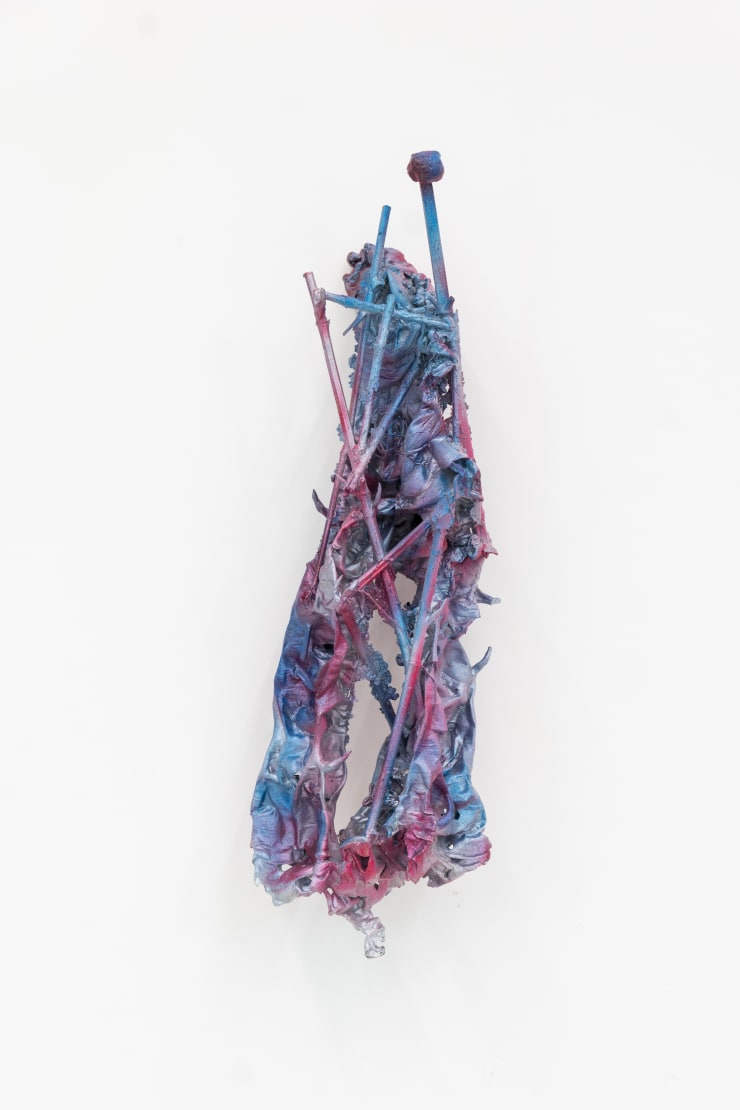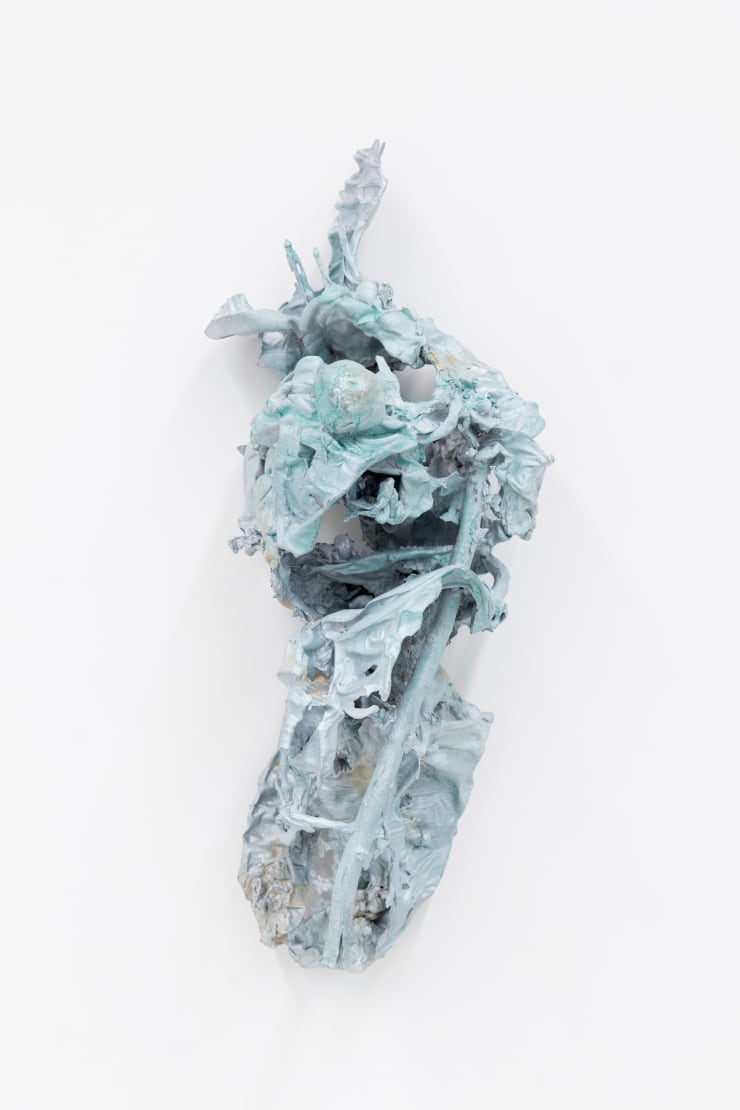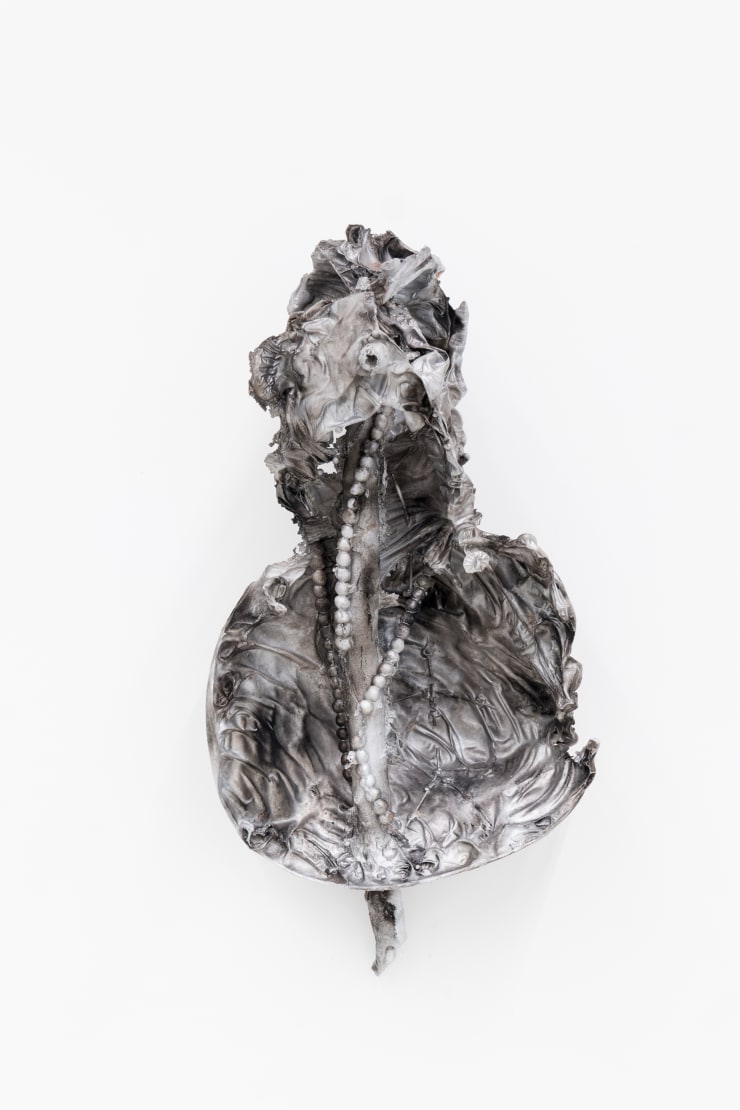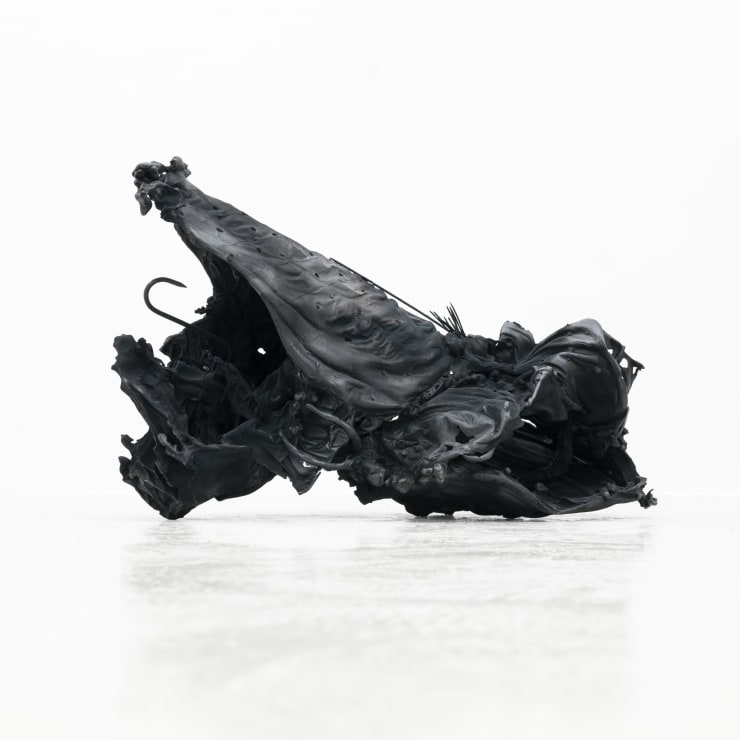Karl Karner | Spiel gerade Höllentor
The latest works of Karl Karner are an explosive amalgamation of antagonisms: cold and hot, static and dynamic, dry and wet, old and new are on a permanent collision course. A precarious celebration of the antithetical which generates works based on elaborate artistic casting techniques (lost-wax casting) and experiments with materials such as sand, aluminium, wax and bronze.
Karner's sculptural work addresses the process of formation, activates the recipient's power for free association who, just like responding to a Rorschach test, is looking for figurative analogies; the works avoid definitive statements and an authorial positioning.
Das jüngere Werk Karl Karners ist ein explosives Gemenge von Antagonismen: kalt und heiß, statisch und dynamisch, trocken und nass, alt und neu sind auf permanentem Kollisionskurs. Ein prekäres Fest des Gegensätzlichen, das Arbeiten hervorbringt, die auf aufwendigen kunstgießerischen Techniken (Wachsausschmelzverfahren) und Materialexperimenten mit Sand, Aluminium, Wachs und Bronze beruhen.
Karners skulpturales Werk thematisiert Formbildungsprozesse, setzt die freie Assoziationskraft des Betrachters in Gang, der wie bei einem Rorschachtest nach figurativen Analogien sucht, und vermeidet endgültige Aussagen und auktoriale Setzungen.
Angela Stief | Translated by Susanna Fahle
-
 Höllentor KR, 2016Alluminium, Sand, Pearls, Silikon, Catalytic converter
Höllentor KR, 2016Alluminium, Sand, Pearls, Silikon, Catalytic converter -
 WÜGG, 2016Aluminiumheight 303 cm
WÜGG, 2016Aluminiumheight 303 cm
height 119 1/4 in -
 Höllentor RK, 2016Aluminium90 x 220 x 64 cm
Höllentor RK, 2016Aluminium90 x 220 x 64 cm
35 3/8 x 86 5/8 x 25 1/4 in -
 BELZU, 2016Aluminiumheight 315 cm
BELZU, 2016Aluminiumheight 315 cm
height 124 1/8 in -
 Höllenbrett, 2016Aluminium, Sand, Pearls230 x 128 x 85 cm
Höllenbrett, 2016Aluminium, Sand, Pearls230 x 128 x 85 cm
90 1/2 x 50 3/8 x 33 1/2 in -
 Schlagzeug, 2016Spray Paint on Aluminium86 x 20 x 24 cm
Schlagzeug, 2016Spray Paint on Aluminium86 x 20 x 24 cm
33 7/8 x 7 7/8 x 9 1/2 in -
 AL Land, 2016Aluminium, Sand, Pearls124 x 194 x 7 cm
AL Land, 2016Aluminium, Sand, Pearls124 x 194 x 7 cm
48 7/8 x 76 3/8 x 2 3/4 in -
 Silver K, 2016Spray Paint on Aluminium36 x 82 x 28 cm
Silver K, 2016Spray Paint on Aluminium36 x 82 x 28 cm
14 1/8 x 32 1/4 x 11 1/8 in -
 Fliege, 2016Aluminium38 x 74 x 28 cm
Fliege, 2016Aluminium38 x 74 x 28 cm
15 x 29 1/8 x 11 1/8 in -
 Drachenkopf, 2016Spray Paint on Aluminium30 x 21 x 15 cm
Drachenkopf, 2016Spray Paint on Aluminium30 x 21 x 15 cm
11 3/4 x 8 1/4 x 5 7/8 in -
 Kastanie, 2016Aluminium62 x 59 x 36 cm
Kastanie, 2016Aluminium62 x 59 x 36 cm
24 3/8 x 23 1/4 x 14 1/8 in -
 Höllenpass, 2016Aluminium, Catalytic converter89 x 227 x 3 cm
Höllenpass, 2016Aluminium, Catalytic converter89 x 227 x 3 cm
35 1/8 x 89 3/8 x 1 1/8 in -
 Perlruß, 201633 x 67 x 29 cm
Perlruß, 201633 x 67 x 29 cm
13 x 26 3/8 x 11 3/8 in -
 KS Schwarz, 2016Aluminium60 x 42 x 29 cm
KS Schwarz, 2016Aluminium60 x 42 x 29 cm
23 5/8 x 16 1/2 x 11 3/8 in -
 Quartzsand, 2016Aluminium, Quartzsand, catalytic converter80 x 203 cm
Quartzsand, 2016Aluminium, Quartzsand, catalytic converter80 x 203 cm
31 1/2 x 79 7/8 in -
 Schattenschuhe, 2016Bronze13 x 30 cm
Schattenschuhe, 2016Bronze13 x 30 cm
5 1/8 x 11 3/4 in
Das jüngere Werk des 1973 in Feldbach geborenen Künstlers, der in der Oststeiermark und in Wien lebt und arbeitet, ist ein explosives Gemenge von Antagonismen: kalt und heiß, statisch und dynamisch, trocken und nass, alt und neu sind auf permanentem Kollisionskurs. Ein prekäres Fest des Gegensätzlichen, das Arbeiten hervorbringt, die auf aufwendigen kunstgießerischen Techniken (Wachsausschmelzverfahren) und Materialexperimenten mit Sand, Aluminium, Wachs und Bronze beruhen. Karners skulpturales Werk thematisiert Formbildungsprozesse, setzt die freie Assoziationskraft des Betrachters in Gang, der wie bei einem Rorschachtest nach figurativen Analogien sucht, und vermeidet endgültige Aussagen und auktoriale Setzungen. Die Performanz der Form, die aus kunsthistorischer Sicht ihren Ursprung in Auguste Rodins Höllentor hatte und sich aus der amorphen Masse des bloßen Materials fast heroisch zur Figuration erhob, übersetzt der Künstler in scheinbar organisch wuchernde, archaische Formen, die er häufig mit objets trouvés kombiniert. Den Zugang zu seiner Kunst, die sich aus einer dunklen Farbpalette nährt und aus schweren und harten Materialien besteht, bezeichnet Karner als spielerisch: Ein höllisches Spiel, in dem das Naturwüchsige mit dem Kunstfertigen eine morganatische Verbindung eingeht.
Das räumliche Setting der Schau, die neben den kleinen, preziösen, manchmal mit Ruß kolorierten oder pastellfarbenen Arbeiten ein Aquarium mit unterwassergezogenen Wachsarbeiten zeigt, folgt einem aleatorischen Prinzip: Große, schwere Aluminiumplatten akzentuieren die Ausstellung, sie werden aneinandergelehnt oder in fragile Balanceverhältnissen gesetzt.
Die kleinen Skulpturen, die trotz ihrer offensichtlichen Gemachtheit so sehr an Urformen, rhizomatische Strukturen und Dschungelgewächse denken lassen, dynamisieren den Raum und bringen die statische Materie zum Tanzen. Man könnte auch sagen, dass Karl Karner den abstrakten Expressionismus nach dem Vorbild von Jackson Pollock in die Dreidimensionalitättreten lässt und seine performative Arbeit mit Linda Samaraweerova in der Skulptur ästhetisch verdichtet.
Angela Stief
___________________________________________________________________________________________________
The latest work of the artist, born in Feldbach in 1973, who lives and works in Eastern Styria and Vienna, is an explosive amalgamation of antagonisms: cold and hot, static and dynamic, dry and wet, old and new are on a permanent collision course. A precarious celebration of the antithetical which generates works based on elaborate artistic casting techniques (lost-wax casting) and experiments with materials such as sand, aluminium, wax and bronze. Karner’s sculptural work addresses the process of formation, activates the recipient’s power for free association who, just like responding to a Rorschach test, is looking for figurative analogies; the works avoid definitive statements and an authorial positioning. The performance of form, which – from an art historical point of view – originated in August Rodin’s “The Gates of Hell” and arose almost heroically into figuration, is translated by the artist into apparently proliferating, archaic shapes, often combined with objets trouvés. Karner describes the approach to his art – which is fuelled by a dark colour palette and consists of heavy and solid materials – as playful: a hellish game in which the elemental and the artistic coalesce in a morganatic union.
The spatial setting of the exhibition that features next to the small, precious, sometimes soot- sometimes pastel-coloured works, also a tank with works of wax moulded under water, follows an aleatoric principle: Large and heavy aluminium plates accentuate the exhibition, they are propped against each other or put into a fragile equilibrium.
The small sculptures that, despite obviously being made, remind very much of primeval forms, rhizomatic structures and the vegetation of a jungle, dynamize the space and make static matter dance. One could also say that Karl Karner puts the abstract expressionism into the three-dimensional along the lines of Jackson Pollock and aesthetically condenses his performative work with Linda Samaraweerova by way of sculpture.
Angela Stief



